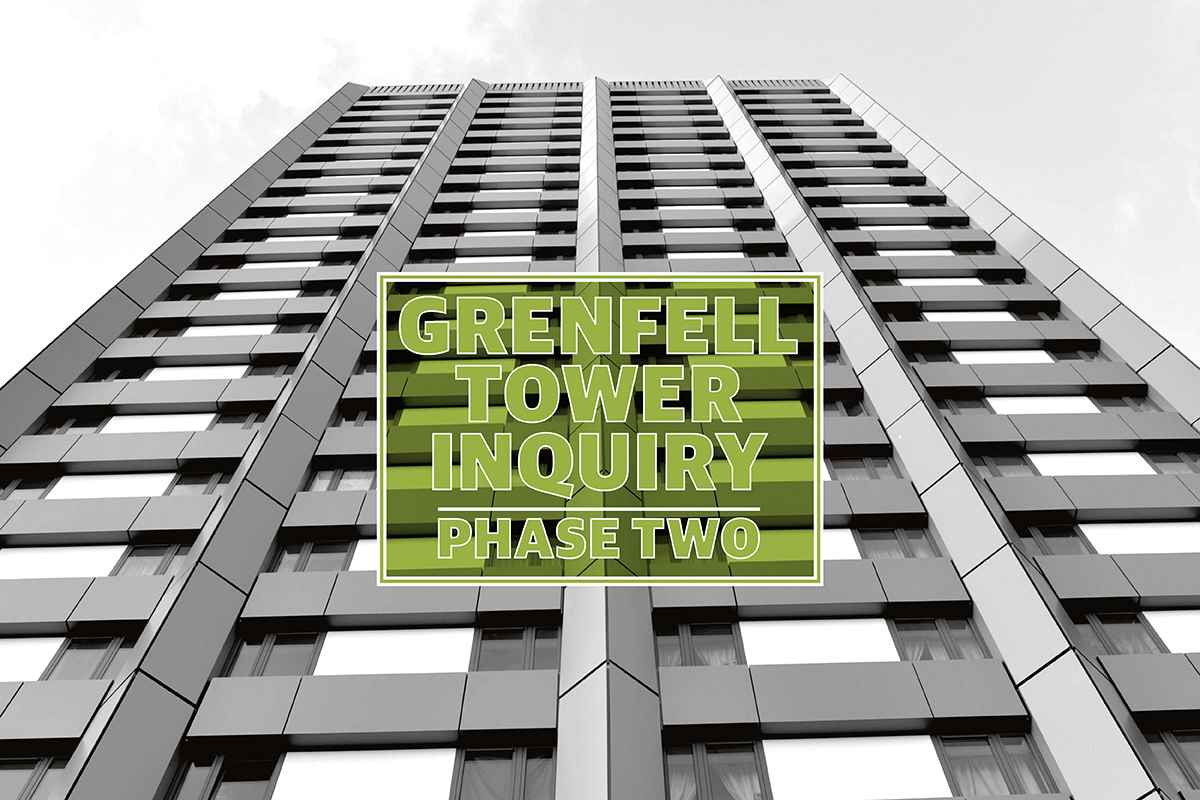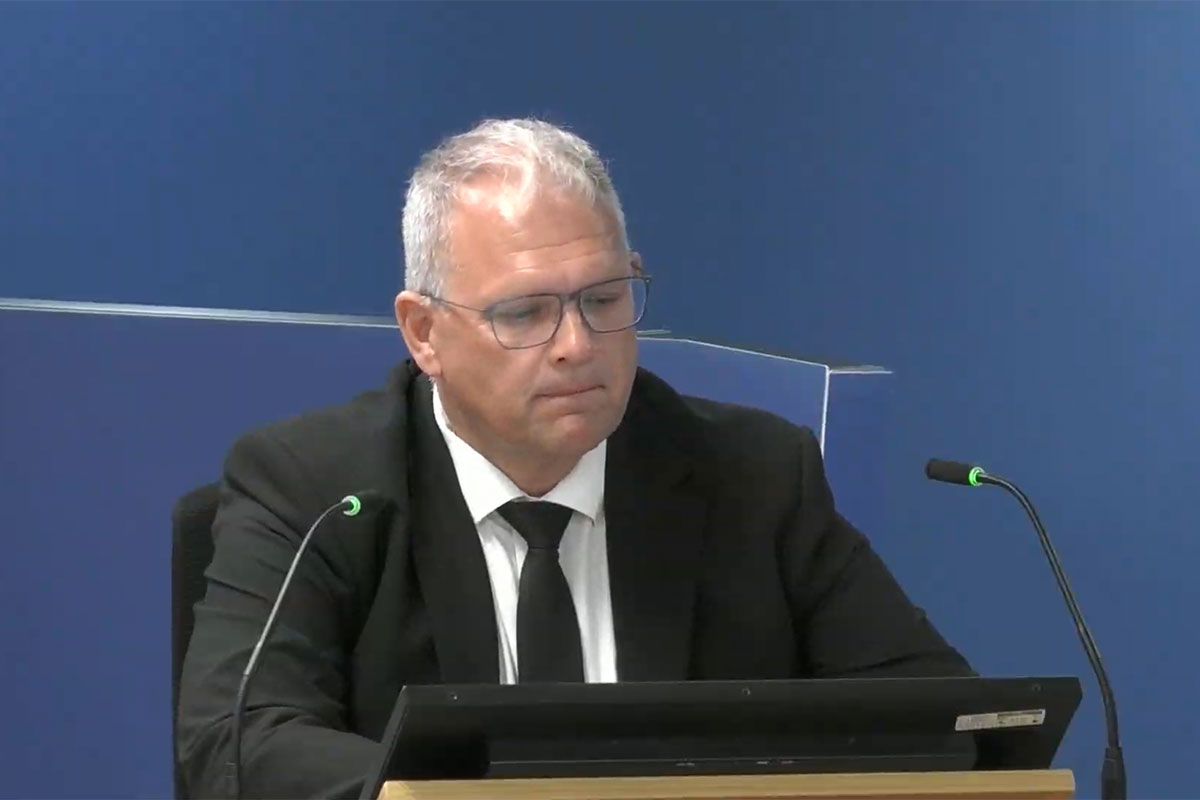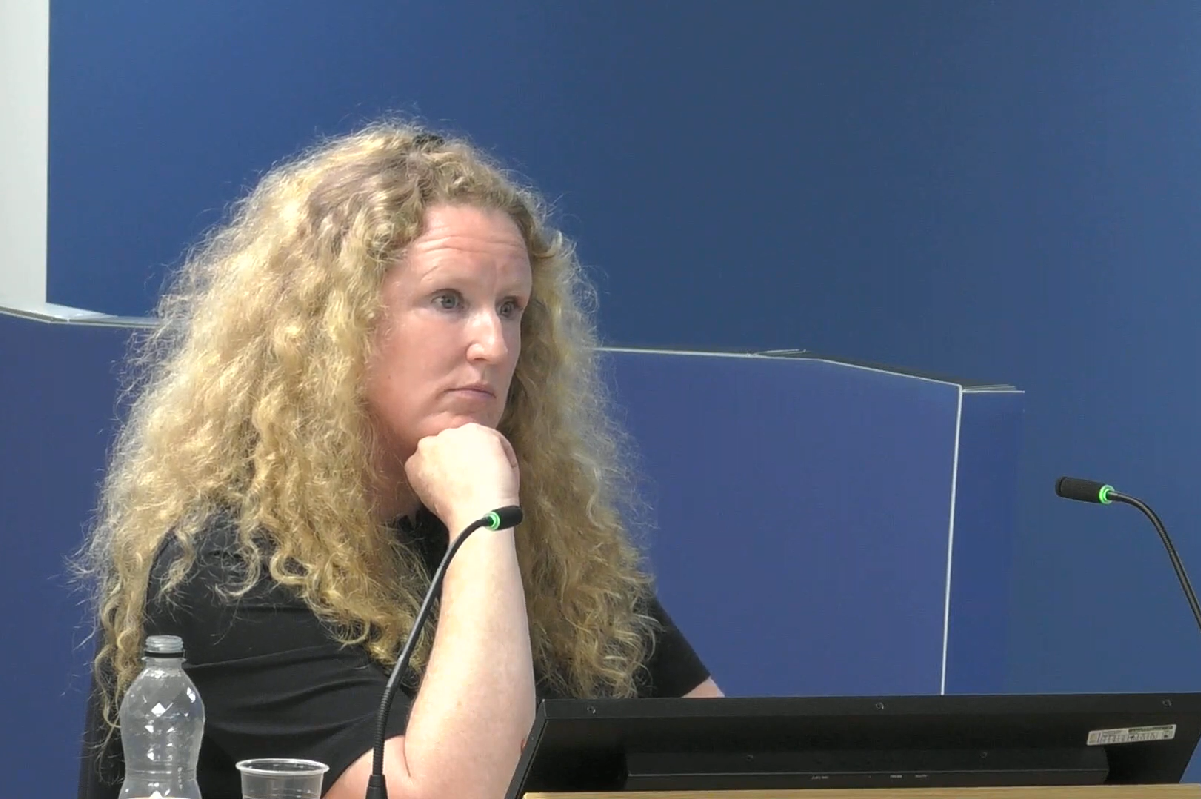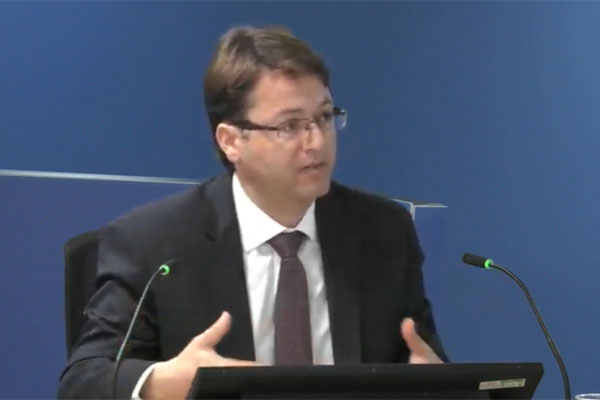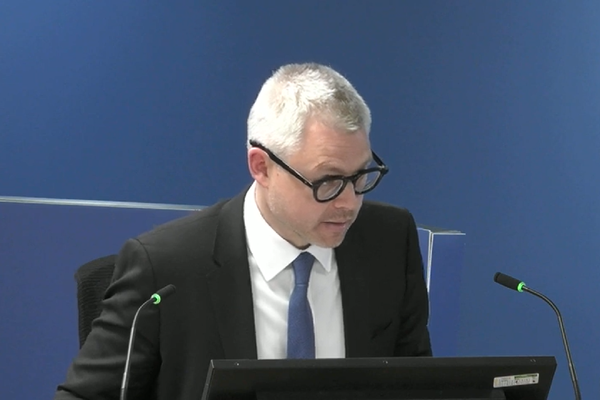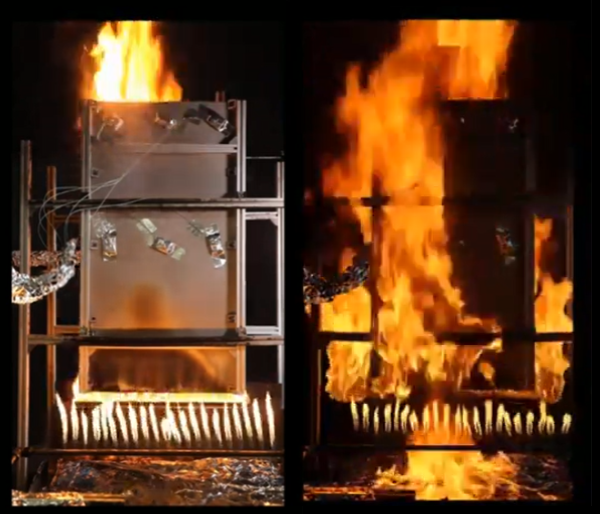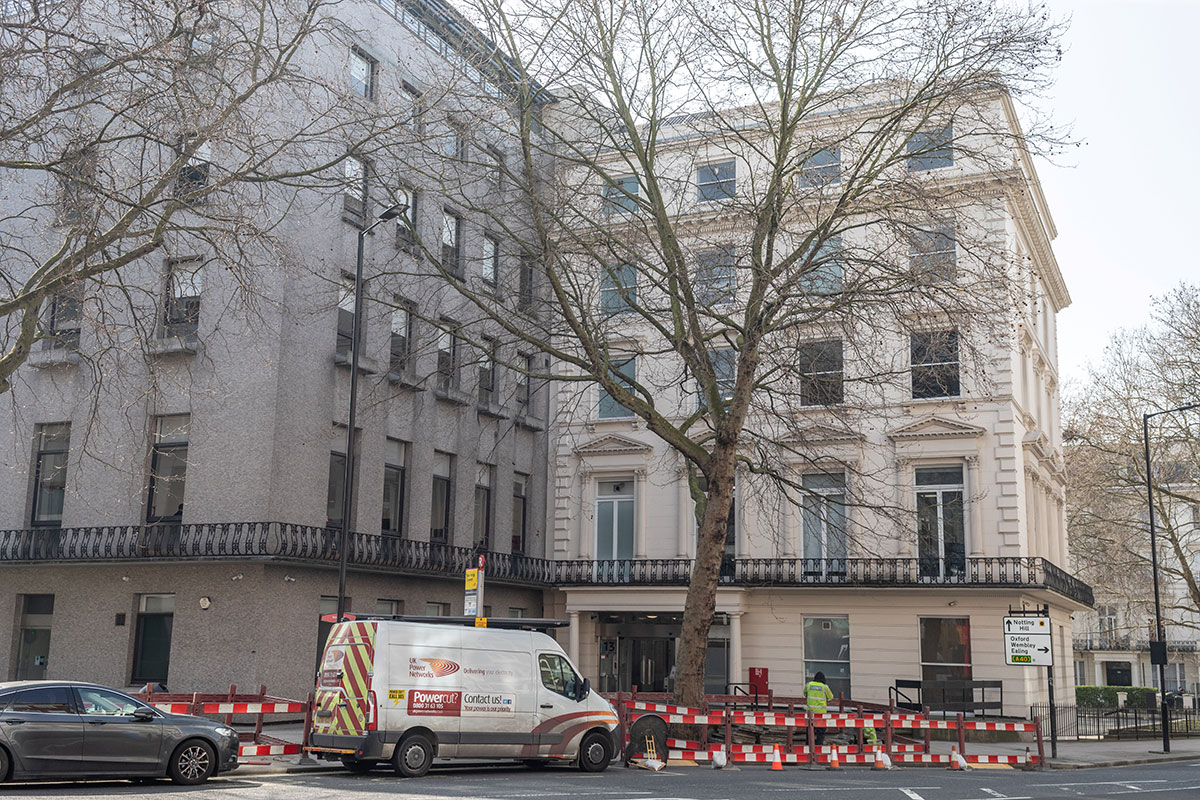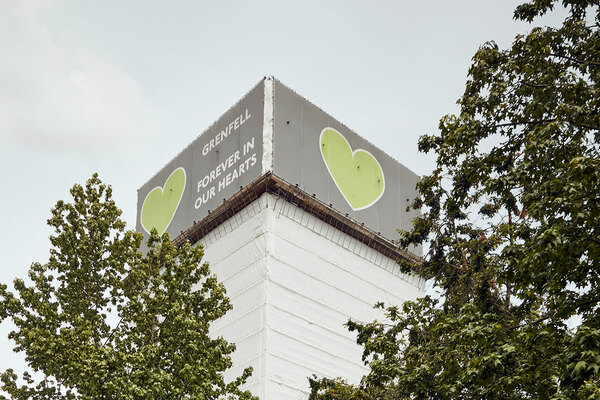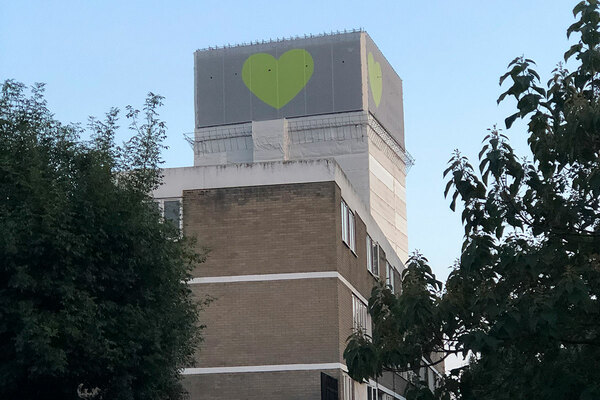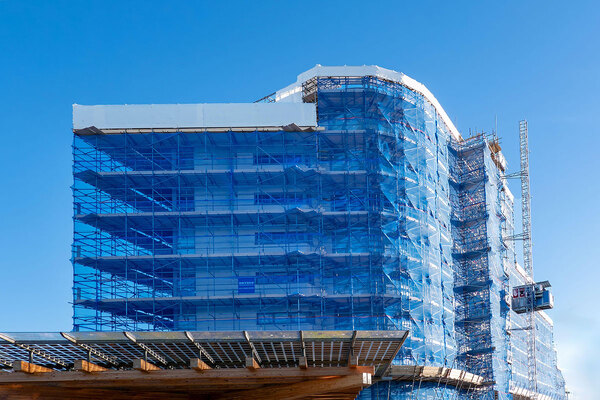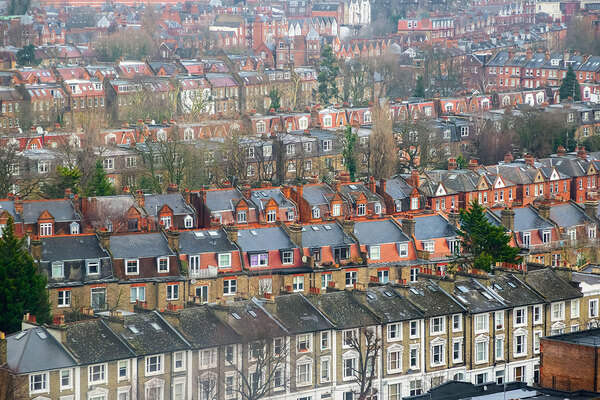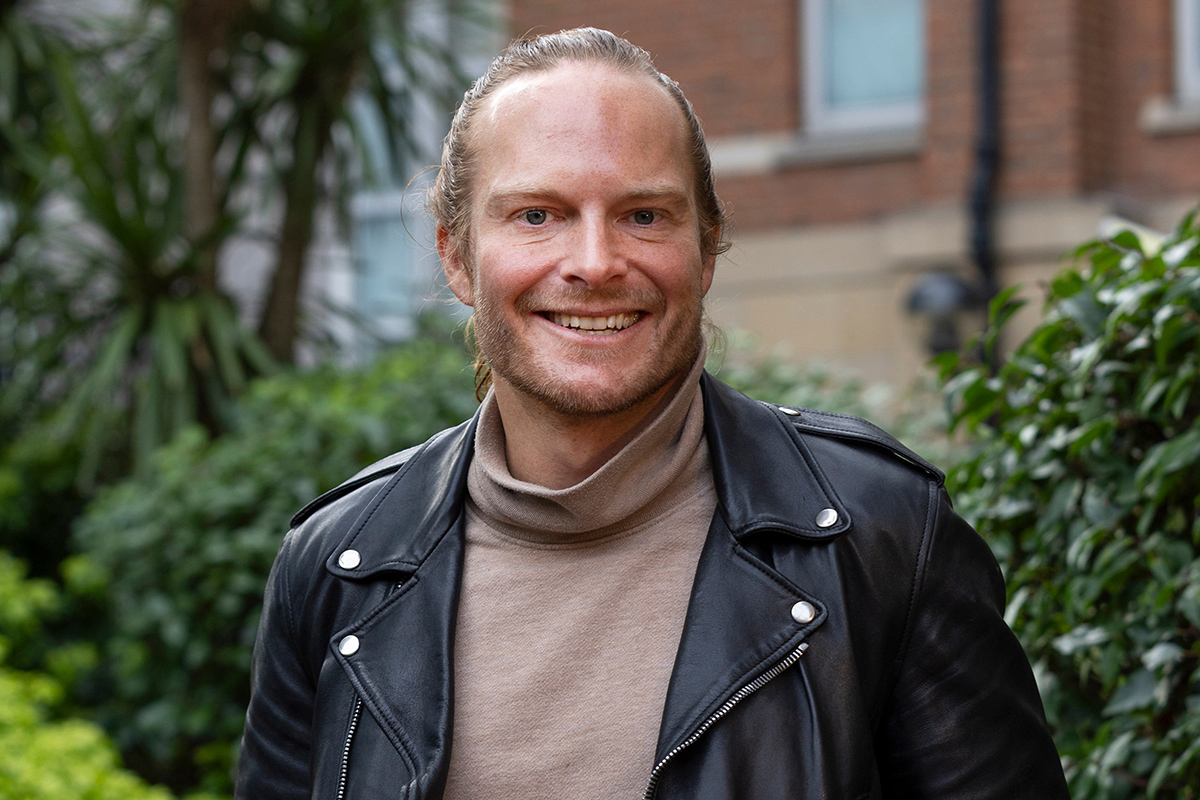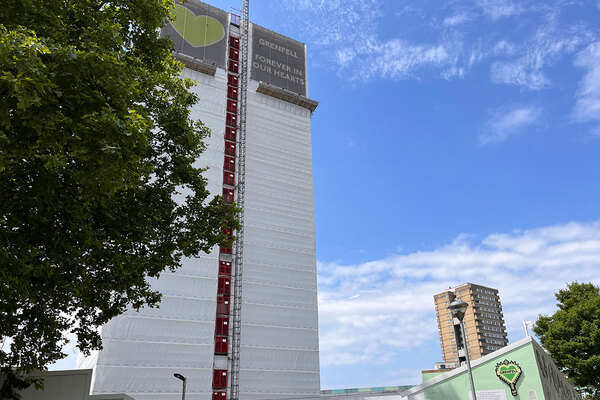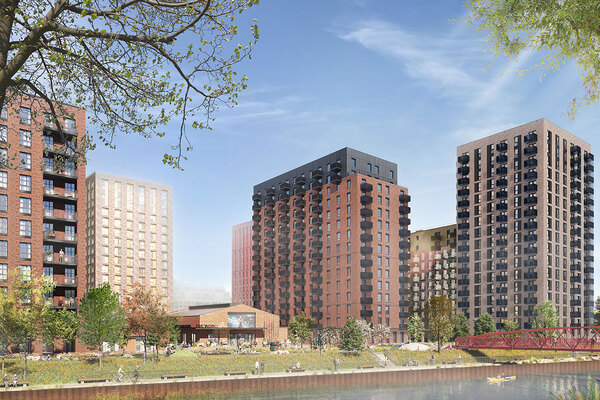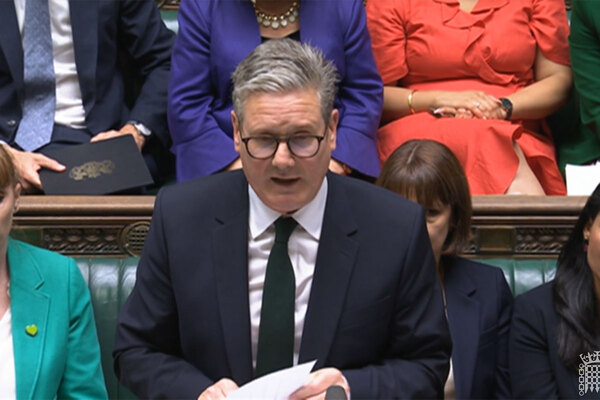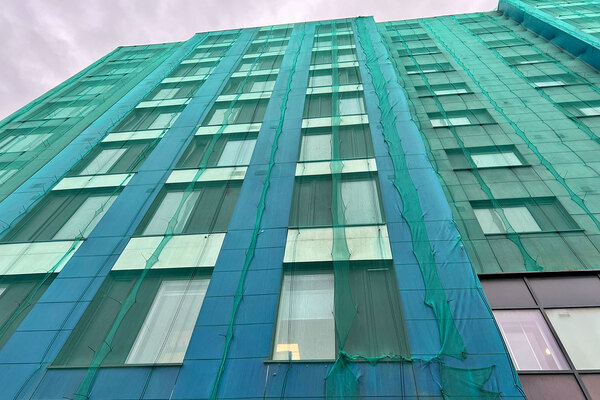Grenfell Tower Inquiry diary week 78: ‘The abandonment of the ‘stay put’ strategy for high-rise residential buildings is essential’
This week the Grenfell Tower Inquiry heard a range of expert witnesses discuss their reports. Peter Apps and Grainne Cuffe report
Five expert witnesses gave evidence this week, covering Grenfell Tower’s smoke control system, the use of water by the London Fire Brigade, the materials used in the blocks’s cladding system, and the adequacy of our methods for testing the safety of these materials generally.
We will start with the smoke control, which was the focus of evidence from two witnesses.
‘I would say there is a prevalence of poor practice in that area’
By way of background, factual evidence about the smoke control system occupied a couple of weeks of evidence almost exactly a year ago.
Grenfell Tower had a new system fitted in 2016, designed by firm PSB UK, due to the old one being broken “beyond repair”.
But this system was not standard. Designer Hugh Mahoney told the inquiry that he was forced to use a bespoke design due to the columns in the tower being too thin to accommodate a more traditional system.
The problem was that this new system did not meet basic standards and was untested elsewhere. This was something Mr Mahoney accepted, but defended on the basis that refurbishment work to an existing building only requires ‘betterment’, ie the new system is only required to be better than what was there before, not necessarily compliant with modern standards.
The first witness called to discuss this issue was Simon Lay (pictured above), a chartered fire engineer who has long experience of preparing fire strategies for high-rise residential buildings.
Unlike the other witnesses called this week, Mr Lay was not instructed by the inquiry. Instead, he was asked to write his report by PSB UK. The inquiry called him to question him on the findings.
Mr Lay’s report was broadly positive about the performance of the system, which was only ever expected to deal with a fire on one floor, not multiple fires burning simultaneously throughout the building.
He said the system “operated as intended” when the fire broke out in flat 16 on the fourth floor of the tower and that it was likely it “operated beyond its expected parameters despite the failure of other provisions that it relied upon”.
He also said the system, which focused on keeping smoke out of the stairway rather than clearing it from the lobbies, “was the most appropriate design response” to the constraints of the tower.
“I have not been able to identify any appropriate smoke control system design capable of installation within the constraints of the tower which could have explicitly addressed both the lobbies and the stair maintaining tenable conditions in both at the same time,” he said.
Mr Lay did criticise industry practice in general. He said designers did not generally run computer modelling simulations of their systems to test the smoke flow, adding that this has become the “norm” in the industry and that there is a “prevalence of poor practice in that area”.
‘The fundamental issue is not the system type PSB chose, it’s the quality of the system they designed’
Following Mr Lane was the inquiry’s expert Dr Barbara Lane (pictured above), who was far more critical of the smoke control system.
She said she did not accept the idea that the regulations accepted ‘betterment’ alone as an acceptable performance standard.
Instead, she said this was narrowly limited to its performance against a specific standard and that, in the case of a broken system, applied to its performance when working as it was originally designed.
“That is a slightly prevailing culture in industry: that if it’s generally slightly better, you know, the job is done,” she said. “And I, long before this inquiry, have never shared that [view]. I don’t believe that’s how that regulation was written.”
Dr Lane criticised PSB’s design for only modelling its performance on circumstances where the only open door was the one that led to the stairs. This was a set of circumstances which never occurred during the fire, with at least one flat entrance door open at some stage on every floor.
“Is it your view that designing a system with just one single stair door being open, with all other doors being closed, was an unrealistic design assumption?” asked Kate Grange QC, counsel to the inquiry.
“Once you’ve worked out how to produce an airflow through the open stair door, anything that weakens that or causes that to reduce, means that you can’t meet your offered design target,” Dr Lane replied.
Her report concluded the “fundamental issue is not the system type PSB chose, it’s the quality of the… system they designed”. “PSB failed to provide a smoke ventilation system which complied with the functional requirements of the building regulations,” she wrote.
“Does that remain your view?” asked Ms Grange.
“Yes,” replied Dr Lane.
‘LFB did not articulate, quantify and communicate their water supply flow rate needs to Thames Water’
On Wednesday, the inquiry heard from Dr Ivan Stoianov (pictured above), a civil engineer and an expert in water supply networks.
Dr Stoianov’s evidence has been long-awaited since the opening statements to the module covering firefighting back in September last year, when lawyers referenced his conclusion that if the equipment available on the night had been correctly used, it would have been “capable of launching water to the top of the building”.
This was described by Danny Friedman QC, appearing for a group of bereaved and survivors, as “an extraordinary possibility for the [bereaved and survivors] to have to contemplate four years after the fire”.
Dr Stoianov did not think this would have been enough to put out the fire, but it may have slowed its spread inside flats giving people time to escape or be rescued.
It emerged on Wednesday that, in response to Dr Stoianov’s findings, the London Fire Brigade (LFB) conducted water flow tests on its firefighting equipment last year to assess whether his theoretical estimates could be achieved in practice.
These tests concluded that reaching the top of the building was not possible.
But Dr Stoianov told the inquiry that the LFB had not followed “even basic standards in performing [the] experimental tests”.
In a supplementary report, he said the brigade did not supply the tested monitors – nozzles – with their ‘rated inlet pressure’ or water flow rate, which measures the amount of water that flows through the nozzle and the force applied to it.
Dr Stoianov agreed that the LFB testing did not cause him to change his previous conclusions.
Questioned on his conclusion that the equipment had not been used properly, he explained that the water flow rate extracted from the hydrants at Grenfell Tower was lower than it could have been and put this down to four factors.
The first was the ‘low-flow discharge coefficient’ of the used hydrants, which means the efficiency at which they allow fluid to flow through.
Second, a ‘wash out’ hydrant was mistakenly labelled and used as a fire hydrant – the former should only be used by Thames Water for washing away debris after works.
Third, there was a lack of co-ordination between the LFB and Thames Water. Fourth, there were pressure losses between the hydrants and pump appliances.
Dr Stoianov criticised LFB’s efforts to communicate with Thames Water about these issues, saying it had “occurred on an ad-hoc basis and, consequently, the communication was qualitative, imprecise and lacked technical rigour”.
“LFB control incident command did not articulate, quantify and communicate their water supply flow rate needs to Thames Water’s network management centre,” he added.
In its first phase, the inquiry heard from firefighters that water-supply problems hampered their efforts, with one saying it left their equipment like a “garden hose”.
“The abandonment of the ‘stay put’ strategy for [high-rise residential buildings] is essential”
On Thursday, the inquiry turned to the issue of cladding with presentations from long-standing inquiry experts, Professor José Torero (pictured above) and Professor Luke Bisby. Both gave presentations on their reports and will be questioned next week.
Professor Torero, a professor of civil engineering at University College London and a globally recognised fire expert, gave his views on the adequacy of the UK’s testing regime for materials used in a facade.
His conclusions were damning – and a call for urgent change.
A key point was that if a building is going to have a ‘stay put’ strategy – as most in the UK do – then any level of external fire spread cannot be tolerated. Doing so will be a breach of the building’s ‘compartmentation’ and put those in other flats at risk.
“Any building envelope that allows for any form of fire spread will not be consistent with a ‘stay-put’ strategy,” he wrote. “Depending on the design of the building, and the building envelope, different approaches can be considered, but all of them will have to guarantee that the fire will not spread beyond the unit where it originated.”
The trouble is, this is an extremely difficult thing to guarantee, and our testing system is not – at least in Professor Torero’s view – up to it.
“The nature of current tests, current testing practices and the information they can deliver is so limited that proper assessment of performance for systems of the complexity of those currently implemented in buildings is not possible by these means,” he wrote.
This means our reliance on stay put should be jettisoned. “Current testing practices and the prevailing professional competency do not enable us to make this characterisation [no external fire spread] with confidence. Thus, the abandonment of the ‘stay-put’ strategy for [high-rise residential buildings] is essential,” he wrote.
This is an important conclusion for the current fire safety debate happening outside the inquiry’s walls.
Last month, the government said it planned to reject the proposal that all buildings should have an evacuation plan as it was “disproportionate”.
“The fire and rescue service advise that ‘stay put’ remains the appropriate strategy in the vast majority of such buildings,” the Home Office said in a consultation response. But this is quite literally the opposite of what Professor Torero told the inquiry.
Professor Torero’s criticism did not end with stay put. He also questioned the BS 8414 large-scale test, which the inquiry has heard much evidence about over the past two-and-a-half years.
He warned that a cladding system could “meet the [pass] criteria and yet still be entirely incompatible with the fire safety strategy of a high-rise residential building with a stay put policy”.
This also presents a challenge to the current policy position: the government recently endorsed the use of these tests to justify the use of combustible materials on buildings between 11 and 18 metres in height.
A broader point was the complexity and difficulty of making sound judgements about the performance of a building facade, compared with the lack of competency in the industry and evidenced at the inquiry.
“I have not been presented with any evidence that indicates that those participating in the design, build, maintenance and operation of Grenfell Tower could be involved in a re-cladding project that used anything but non-combustible materials,” Professor Torero wrote.
‘These were some of the most shocking experiments I have ever witnessed after about 15 years of working in these labs’
Trigger warning: this section features an image of the cladding material used on Grenfell Tower burning during a fire test
Professor Torero was followed into the witness box by Professor Bisby (pictured above), who presented findings from a series of tests on the cladding materials used on Grenfell Tower.
Central to this work was a series of bespoke experiments that he and his team devised to test the impact of a ‘cavity’ on the fire performance of the system.
The ‘cavity’ refers to the gap left in some cladding systems between the insulation, which is fixed directly to the wall, and the external cladding panels, which are fixed or hung on a purpose built frame.
This feature has long been thought to be significant in the level of fire risk posed by a cladding system, and Professor Bisby’s work supported this conclusion.
He built a bespoke system which saw a row of flames inserted into the cavity for a period of four minutes before being removed.
The first test he presented, which utilised Kingspan’s K15 insulation behind the aluminium composite material (ACM) cladding used on the tower, demonstrated what he called “a very rapid and violent escalation of burning”.
After around 10 minutes, with the flame licking up the back of the cladding panel inside the facade, the system suddenly collapsed into huge flames as the aluminium separated from the polyethylene, exposing the ferociously combustible plastic to the blaze.
The below images show this occurring, and are of the same system a mere 30 seconds apart:
Professor Bisby said the rate of this escalation came as a shock to him. Issuing a trigger warning to those watching, he said: “Even having witnessed this escalation in person now dozens of times, I still find it pretty shocking.
“Indeed, the comparatively small size of our experiments, in general terms, was dictated by the fact that these were the largest experiments that we felt we could safely perform within our purpose-built fire labs.
“These were some of the most shocking experiments I have ever witnessed after about 15 years of working in these labs.”
Professor Bisby’s work sought to establish why this effect occurred. He re-ran the test on the ACM alone, without the cavity. This time, the escalation did not occur.
Then he tried it with a stainless steel backing to create the geometry of a cavity, but cooled it with water. Once more, the escalation did not occur.
Next he tried it with insulation inside the cavity, but with a non-combustible variety of the insulation. This time the escalation occurred, in almost exactly the same way – but later.
The conclusion, therefore, was that the insulation inside the cavity was significant in making the fire behave in the way it did, but because of its thermal performance in holding the heat in more than its combustibility.
Further experiments examined the impact of applying heat to small samples of the materials.
A 10cm x 10cm square of the ACM exhibited startling burning, causing a fire which continued for several minutes and sent a stream of molten, burning plastic into a debris tray.
Professor Bisby described the piece tested as “about the size of a beermat or a drinks coaster”. “If you run the numbers, which I’ve done, you would find that a typical single-storey column cassette from Grenfell Tower would contain about 270 of these,” he said.
Tests on the foam insulation – both the materials made by Kingspan and Celotex – showed quick ignition and substantial burning when tested without their customary foil facer. However, when the facer was included, neither sample ignited.
Professor Bisby said his research supported his finding from the first phase of the inquiry, that the ACM was “the primary cause of rapid fire growth” and the “upward, downward and horizontal fire spread”.
However, he added that his research did not consider the issue of smoke. “Questions around toxicity and smoke production are relevant, but are being addressed by other experts to the inquiry,” he said.
Professor Bisby added: “I want to emphasise that just because the physics tells us that a particular material or product may or may not have governed what occurred at Grenfell Tower, this does not, in my view, mean that the inquiry shouldn’t seek to understand as fully and completely as possible how these products came to be installed within Grenfell Tower… or the culture and context within which this occurred.”
The inquiry continues next week with questioning of both professors and evidence from other experts.
Grenfell Tower Inquiry week 78: headlines
‘Prevalence of poor practice’ in design of smoke systems, expert tells inquiry
There is a “prevalence of poor practice” in the industry which designs smoke control systems and it has become the “norm” for specialists not to model individual systems, an expert witness told the Grenfell Tower Inquiry.
Grenfell Tower smoke system failed to comply with requirements of regulations
The designers of Grenfell Tower’s smoke control system failed to meet the functional requirements of building regulations when they replaced the building’s system with a new, bespoke model in 2016, an expert witness told the inquiry.
LFB did not follow ‘even basic standards’ in firefighting equipment tests, says expert
A water-systems expert who concluded that water supply could have reached the top of Grenfell Tower on the night of the fire has disputed the London Fire Brigade’s conclusions that it was not possible.
‘Essential’ that ‘stay put’ is abandoned for high rises, expert tells Grenfell Inquiry
It is “essential” that the ‘stay put’ policy for high-rise buildings is “abandoned” because the risk of fires spreading externally cannot be properly assessed under current methods, an expert witness to the Grenfell Tower Inquiry has said.
Sign up for our weekly Grenfell Inquiry newsletter
Each week we send out a newsletter rounding up the key news from the Grenfell Inquiry, along with the headlines from the week
Already have an account? Click here to manage your newsletters
Grenfell Tower Inquiry phase two: weekly diaries
Module one: the refurbishment
Week one: A vivid picture of a broken industry
After a week of damning revelations at the opening of phase two of the Grenfell Tower Inquiry, Peter Apps recaps the key points
Click here to read the full story
Week two: What is the significance of the immunity application?
Sir Martin Moore-Bick has written to the attorney general requesting protection for those set to give evidence at the Grenfell Tower Inquiry. Peter Apps explains what the move means
Click here to read the full story
Week three: Architects of misfortune
This week saw the lead architects for the Grenfell Tower refurbishment give evidence to the inquiry. Peter Apps runs through the key points
Click here to read the full story
Week four: ‘I didn’t have any perception that it was the monster it’s become’
The architects continued to give evidence this week, outlining a lack of understanding of the fire risk posed by the cladding materials and its design. Nathaniel Barker reports
Click here to read the full story
Week five: ‘No adverse effect in relation to external fire spread’
As the Grenfell Tower Inquiry returns from its long absence, Peter Apps recaps the key points from a week of important evidence from the fire consultants to the refurbishment
Click here to read the full story
Week six: ‘I can’t recall any instance where I discussed the materials with building control’
Nathaniel Barker summarises what we learned from fire engineers Exova, architects Studio E and the early evidence from contractor Rydon
Click here to read the full story
Week seven: ‘I do not think I have ever worked with a contractor operating with this level of nonchalance’
Two key witnesses from contractor Rydon gave evidence this week. Peter Apps recaps some of the key points from a revealing week of evidence
Click here to read the full story
Week eight: ‘It haunts me that it wasn't challenged’
Four witnesses from contractor Rydon gave evidence this week. Lucie Heath recaps what we learned on the last week of evidence before the inquiry breaks for five weeks
Click here to read the full story
Week nine: ‘All I can say is you will be taken out for a very nice meal very soon’
This week the inquiry heard evidence from witnesses at Harley Facades, the sub-contractor responsible for Grenfell Tower’s cladding. Peter Apps recaps the key points
Click here to read the full story
Week 10: ‘As we all know, ACM will be gone rather quickly in a fire!’
As the Grenfell Tower Inquiry entered its 10th week, Jack Simpson recaps the key points from a week of important evidence from the refurbishment’s cladding contractor
Click here to read the full story
Week 11: ‘Did you get the impression Grenfell Tower was a guinea pig for this insulation?’
With witnesses from the cladding subcontractor, the firm which cut the deadly panels to shape and the clerk of works which inspected the job giving evidence this was week full of revelations. Peter Apps recaps the key points
Click here to read the full story
Week 12: ‘Would you accept that was a serious failing on your part?’
With the surveyor who inspected Grenfell Tower for compliance giving evidence, this was a crucial week from the inquiry. Dominic Brady and Peter Apps report
Click here to read the full story
Week 13: ‘Value for money is to be regarded as the key driver for this project’
With consultants to Kensington & Chelsea Tenant Management Organisation (KCTMO) giving evidence, attention at the Grenfell Tower Inquiry turned for this first time to the actions of the TMO and the council. Peter Apps reports
Click here to read the full story
Week 14: ‘Did it not occur to you at this point that your budget was simply too low?’
This week, for the first time in phase two, the inquiry heard from Kensington & Chelsea Tenant Management Organisation, the landlord that oversaw the fatal refurbishment of Grenfell Tower. Lucie Heath reports
Click here to read the full story
Week 15: ‘Have you ever informed the police that you destroyed documents relevant to their investigation?’
Witnesses from the Kensington and Chelsea Tenant Management Organisation (KCTMO) gave evidence for a second week, which began with a shocking revelation about withheld and destroyed evidence. Peter Apps recaps
Click here to read the full story
Week 16: ‘I conclude this was very serious evidence of professional negligence’
This week saw members of Kensington & Chelsea Tenant Management Organisation finish giving evidence, before the inquiry’s expert witnesses took the stand to make some highly critical assessments of the work they had seen before and during the refurbishment of Grenfell Tower. Jack Simpson recaps
Click here to read the full story
Grenfell Tower: a timeline of the refurbishment
Following the conclusion of module one of the Grenfell Inquiry’s second phase, Peter Apps presents a timeline of the key moments during the fatal refurbishment of the west London tower block
Click here to read the full story
Module two: the cladding products
Week 17: ‘It’s hard to make a note about this because we are not clean’
The start of the second module of the Grenfell Tower Inquiry phase two came with some huge revelations about the companies that sold the products used in the cladding system. Peter Apps reports
Click here to read the full story
Week 18: ‘It was just reckless optimism wasn't it?’
As the inquiry began cross-examining witnesses for the second module of its phase two work, the picture surrounding just how Grenfell Tower ended up wrapped in such dangerous materials became a little clearer. Nathaniel Barker was keeping an eye on proceedings
Click here to read the full story
Week 19: ‘And that was intentional, deliberate, dishonest?’
The Grenfell Tower Inquiry this week heard the shocking story of how the insulation manufacturer “manipulated” official testing and marketed its product “dishonestly”. Peter Apps tells the story
Click here to read the full story
Week 20: ‘We were outed by a consultant who we then had to fabricate a story to’
This week the inquiry investigated the actions of Kingspan – the manufacturer of one of the insulation products used in the tower’s cladding system. Dominic Brady reports
Click here to read the full story
Week 21: ‘It’s there in black and white isn't it? We see a complete absence of any consideration of life safety’
The story of insulation giant Kingspan’s testing and marketing of its combustible insulation for high rises was unpacked in minute detail this week. Peter Apps reports
Click here to read the full story
Week 22: ‘All we do is lie in here’
In the third week of evidence from insulation giant Kingspan, the inquiry continued to uncover shocking details about the firm’s behaviour both before and after the Grenfell Tower fire. Lucie Heath reports
Click here to read the full story
Week 23: ‘That would have come as an earthquake to you at the time, would it not?’
This week the inquiry took its deepest dive yet into the inner workings of the cladding manufacturer whose product has been blamed for the terrible spread of fire up Grenfell Tower. Nathaniel Barker reports
Click here to read the full story
Week 24: ‘Do you accept that Test 5B was Arconic's deadly secret’
The president of the firm that made and sold the cladding panels installed on Grenfell Tower was asked to account for the apparent concealment of “disastrous” fire tests on the product this week. Peter Apps reports
Click here to read the full story
Week 25: ‘This is quite an incredible list of omissions and missed instances, isn’t it?’
This week the Grenfell Tower Inquiry heard its first witnesses from the Building Research Establishment (BRE) - the testing house which carried out key fire tests on the Kingspan and Celotex insulation products which were later used on Grenfell Tower. Peter Apps reports.
Click here to read the full story
Week 26: 'You were taking an enormous risk, weren't you?'
Week 26 at the Grenfell Tower Inquiry was a key moment in understanding how dangerous products used on the tower came to be accepted by industry professionals. Dominic Brady reports
Click here to read the full story
Week 27: ‘What will happen if one building made out [of] PE core is in fire and will kill 60 to 70 persons?’
The most explosive evidence this week at the Grenfell Tower Inquiry came from those who did not attend, as the evidence which would have been presented to Arconic witnesses was displayed in their absence. Peter Apps reports
Click here to read the full story
Week 28: ‘This is a serious safety matter’
This week the Grenfell Tower Inquiry zeroed in on the British Board of Agrément, the body that produced “misleading” certificates which inspired trust in both the cladding and insulation used on the tower. Lucie Heath reports
Click here to read the full story
Week 29: ‘Is it true that Kingspan’s position… was to do its best to ensure that science was secretly perverted for financial gain?’
The final week in this section of the Grenfell Tower Inquiry primarily examined the attempts by insulation manufacturer Kingspan to lobby government after the fire. Peter Apps reports
Click here to read the full story
How the products used in Grenfell Tower's cladding system were tested and sold
As the section of the Grenfell Tower Inquiry examining how the products used in the cladding system were tested, marketed and sold comes to a close, Peter Apps summarises what we have learned about each of the products included in the system
Click here to read the full story
Module Three: the management of the tower
Week 30: ‘There is certainly a high probability that in the event of a fire the whole building can become an inferno’
The focus of the inquiry shifted this week to the actions of the social housing providers responsible for maintaining Grenfell Tower. Pete Apps recaps what we learned
Click here to read the full story
Week 31: ‘If we cannot get out people will die’
This week saw the former residents of Grenfell Tower enter the witness box to tell of their experiences attempting to raise complaints with the council and its managing agent. Pete Apps reports
Click here to read the full story
Week 32: ‘Let's hope our luck holds and there isn't a fire’
This week saw the return of the landlord of Grenfell Tower, Kensington and Chelsea Tenant Management Organisation (KCTMO), as senior staff members attempted to explain how vital fire safety protections at the block were allowed to fall into disrepair. Lucie Heath reports
Click here to read the full story
Week 33: ‘Isn't that a serious gap in the scope of a policy meant to safeguard vulnerable people?’
A slightly disjointed week at the Grenfell Tower inquiry saw further evidence from staff at building manager Kensington and Chelsea Tenant Management Organisation (KCTMO) interspersed with the views of a cladding expert. Peter Apps reports
Click here to read the full story
Week 34: ‘Some members of the community are doing their best to spread false information’
Jack Simpson covers all the major revelations from the past week of evidence at the Grenfell Inquiry, including evidence from Laura Johnson, director of housing at the Royal Borough of Kensington and Chelsea.
Click here to read the full story
Week 35: ‘I really didn’t like the champagne’
This week the Grenfell Tower Inquiry saw council witnesses, including former deputy leader Rock Feilding-Mellen and leader Nicholas Paget-Brown, questioned about their role in the story for the first time. Peter Apps reports
Click here to read the full story
Week 36: ‘Is that not a very incurious approach for a fire risk assessor?’
This week the Grenfell Tower Inquiry scrutinised the work of Carl Stokes, the man hired to carry out fire risk assessments for the block. Nathaniel Barker reports
Click here to read the full story
Week 37: ‘In giving that advice, weren’t you acting beyond your knowledge and expertise?’
A curtailed week at the Grenfell Tower Inquiry saw fire risk assessor Carl Stokes grilled over advice he gave regarding the tower’s cladding. Peter Apps reports
Click here to read the full story
Week 38: ‘Well it’s a bit more than that, isn’t it. He’s suggesting that you tell the LFB a lie’
The inquiry heard the mammoth cross-examination of KCTMO’s health and safety manager Janice Wray this week. Peter Apps reports
Click here to read the full story
Week 39: ‘What you said there was a grotesque understatement’
This week the inquiry continued to hear from former employees of Kensington and Chelsea Tenant Management Organisation, as well as two employees from the London Fire Brigade. Lucie Heath reports
Click here to read the full story
Week 40: ‘An exercise in concealment and half-truth’
Former KCTMO chief executive Robert Black gave his evidence to the inquiry this week and was asked to account for the various failures described over the previous six weeks. Peter Apps and Nathaniel Barker report.
Click here to read the full story
Week 41: ‘We should do nothing. This is not the sort of website we should be responding to’
This week saw the return of Robert Black, chief executive of Kensington and Chelsea Tenant Management Organisation (KCTMO), before the inquiry turned its attention to the defective smoke control system in the tower. Dominic Brady reports
Click here to read the full story
Week 42:‘They would leak as much as they leaked. They were what they were’
The Grenfell Tower Inquiry continued its in-depth investigation of the tower’s non-compliant smoke control system this week, with evidence from the various contractors involved in delivering it. Pete Apps reports
Click here to read the full story
Week 43:‘Contractors at the time were not generally aware of the importance of leaving holes unsealed’
This week the inquiry focused on two of the more overlooked areas of the Grenfell Tower fire, with evidence focusing on the gas pipelines and lifts within the west London block. It was a packed week, with five witnesses giving evidence. Jack Simpson reports
Click here to read the full story
Week 44:‘I've never seen a fully compliant firefighting lift in any local authority building, to this day actually’
This week the inquiry turn the focus onto the building’s defective lifts, with evidence from an expert, contractors who worked on them and a former engineer at KCTMO. Pete Apps reports.
Click here to read the full story
Week 45: ‘Don’t you find all this rather a surprising debate, given that the Equality Act was passed in 2010?’
The inquiry heard from expert witness Colin Todd this week, who gave his views about the work of risk assessor Carl Stokes as well as answered questions about his own guidance. Peter Apps and Nathaniel Barker report
Click here to read the full story
Week 46: ‘I think I've been very, very clear that is completely wrong’
This week the inquiry heard further expert evidence about fire risk assessor Carl Stokes’ actions, as the section of its work covering the management and maintenance of the tower concluded. Peter Apps reports
Click here to read the full story
Six key failures in the way Grenfell Tower was managed before the fire
Peter Apps recaps some of what we have learned about the actions of the Royal Borough of Kensington and Chelsea (RBKC) and Kensington and Chelsea Tenant Management Organisation (KCTMO) in the years before the fire.
Module one and two closing statements
Week 47: ‘An unedifying spectacle’
After a week of closing statements from the core participants involved in modules one and two, Lucie Heath recaps the key arguments of each group
Click here to read the full story
Module five: the fire brigade
Week 48: ‘They knew, and lives could and should have been saved’
The phase of the Grenfell Tower Inquiry examining the actions of the London Fire Brigade in the years before the fire kicked off this week with some major revelations. Peter Apps reports
Click here to read the full story
Week 49: ‘I'm not sure we've always taken every opportunity to learn as an organisation’
How the London Fire Brigade acted upon lessons from incidents in the years before the Grenfell Tower disaster came under the microscope this week at the public inquiry. Nathaniel Barker reports
Click here to read the full story
Week 50: ‘There is a culture in LFB that is very conservative. I think there is great comfort in what is familiar’
This week the inquiry heard how the London Fire Brigade (LFB) elected not to issue warnings about dangerous cladding before Grenfell and a detailed examination of its policy for checking high risk buildings. Pete Apps reports.
Click here to read the full story
Week 51:‘We teach firefighters to expect building failure’
An unusually brief week of evidence at the Grenfell Tower Inquiry explored how a fire service neighbouring London was taking a different approach to tackling blazes in high rises. Nathaniel Barker reports
Click here to read the full story
Week 52: ‘I actually think that there is a measure of incompetence at all levels’
Expert evidence concluded the current section of the inquiry with some stinging criticism of the London Fire Brigade (LFB). Pete Apps and Grainne Cuffe report.
Click here to read the full story
Module six: fire services
Week 53: ‘They make for chilling reading and harrowing listening’
The inquiry’s investigation into central government began this week with lawyers setting out their view on how and why firefighting policies failed. Peter Apps and Lucie Heath report
Click here to read the full story
Week 54: ‘Our consideration of evacuation at this time was something of a blind spot’
The development of policy on ‘stay put’, both nationally and for London, occupied the attention of the inquiry this week. Peter Apps reports
Click here to read the full story
Week 55: ‘My review is pretty scathing!’
In a week that included the 200th day of evidence in phase two of the inquiry, attention turned to the London Fire Brigade’s control room. Lucie Heath reports
Click here to read the full story
Week 56: ‘Why didn't we thump the table harder’
This week, the control room at the London Fire Brigade was examined further – both before and after the fire. Pete Apps and Lucie Heath report
Click here to read the full story
Week 57: ‘It was worse than slow, it was sluggish’
Former London Fire Brigade (LFB) commissioner Dany Cotton was the star witness this week, as the inquiry continued to delve into the brigade’s knowledge and training before the Grenfell Tower fire. Jack Simpson, Grainne Cuffe and Pete Apps report
Click here to read the full story
Week 58: ‘I don't think we deserve to ask for trust until we demonstrate different outcomes’
A current and former commissioner of the London Fire Brigade (LFB) wrapped up the inquiry’s investigation into the actions of the brigade before the fire. Grainne Cuffe and Peter Apps report.
Module six: testing and government
One of the major scandals of our time: key revelations as the Grenfell Tower Inquiry turns to government
The government was accused of “covering up” the risks of dangerous cladding as its “unbridled passion for deregulation” left it a “junior party” to the construction industry as the latest phase of the public inquiry opened today. Peter Apps summarises some of the main points
Click here to read the full story
Week 59: ‘Recent tests have apparently shown it continued to burn for 20 minutes after the flame was taken away’
After shocking opening statements, the Grenfell Tower Inquiry turned its attention to the work of Local Authority Building Control. Pete Apps reports
Click here to read the full story
Week 60: ‘You could have an exact repeat of the Dubai fire in any number of buildings in London’
The Grenfell Tower Inquiry turned its attention to the work of the National House Building Council this week, with shocking revelations about the extent of the warnings issued to central government before the fire. Peter Apps reports
Click here to read the full story
Week 61: ‘Mistakes are meant for learning, not repeating’
In the first hearings of the new year, the Grenfell Tower Inquiry heard closing statements from the firefighting section of phase two. Lucie Heath reports
Click here to read the full story
Week 62: Did it ever occur to you that this act of collaboration was, in one sense, corrupting?
The Grenfell Tower Inquiry returned to the work of the National House Building Council (NHBC) this week, with a new shocking revelation about the government’s actions in the immediate aftermath of the fire. Peter Apps reports
Click here to read the full story
Week 63: ‘It came after the general move to deregulation. So more regulation was not welcome’
The government’s focus on deregulation before the Grenfell Tower fire was placed in the spotlight this week with a series of shocking revelations about its failure to amend fire safety guidance. Pete Apps and Grainne Cuffe report
Click here to read the full story
Week 64: ‘I didn’t think ACM would be suitable for use in any high-rise buildings. I don’t think anyone did’
This week, the Building Research Establishment’s Dr Sarah Colwell gave more than three days of evidence, with some huge revelations about what was known about the dangers of aluminium composite material years before the fire and the mass confusion over the government’s building regulations. Peter Apps and Jack Simpson report
Click here to read the full story
Week 65: ‘Unless the government does something now about ACM panels, people will die’
Further evidence from the Building Research Establishment and the first government witnesses added new depth to our understanding of how warnings were missed before the Grenfell Tower fire. Peter Apps reports
Click here to read the full story
Week 66: ‘Was there a cover-up?’
The latest evidence from the Grenfell Tower Inquiry tracked the government’s failure to act on fire safety warnings right up until the months before the fire. Peter Apps and Grainne Cuffe report
Click here to read the full story
Week 67: ‘When exposed to a fire, the aluminium melts away and exposes the polyethylene. Whoosh!’
This week the inquiry heard disturbing new evidence about the failure of senior government officials to act on warnings about dangerous cladding in the years before the Grenfell Tower fire. Peter Apps reports
Click here to read the full story
Week 68: ‘Can we agree that was a pretty dangerous thing to have, all this falling on one man’s shoulders?’
Three senior civil servants gave evidence this week, including the official who had responsibility for building regulations guidance on fire safety in the years before Grenfell. Peter Apps, Lucie Heath, Stephen Delahunty and Grainne Cuffe report
Click here to read the full story
Week 69: ‘It was just unthinkable. You had the makings here of a crisis you could not comprehend’
This week, civil servant Brian Martin gave his long-awaited evidence to the Grenfell Tower Inquiry. Peter Apps reports
Click here to read the full story
Week 70: ‘Show me the bodies’
An important week at the Grenfell Tower Inquiry saw a dramatic conclusion to the mammoth cross-examination of civil servant Brian Martin, as well as the first politicians. Peter Apps and Lucie Heath report
Click here to read the full story
Week 71: ‘I have changed my schedule to fit this in. I do have an extremely busy day meeting people’
Three politicians who were responsible for building regulations before Grenfell appeared before the inquiry this week, including the former communities secretary Eric Pickles, who responded to the coroner’s letter following the Lakanal House fire. Peter Apps and Lucie Heath report
Click here to read the full story
Module Four: aftermath
Week 72: 'The system isn't broken. It was built this way'
This week the inquiry turned to the shocking story of the lack of support for bereaved and survivors in the immediate aftermath of the Grenfell Tower fire. Peter Apps, Lucie Heath, Grainne Cuffe and Jack Simpson report
Click here to read the full story
Week 73: ‘Most people would regard that as hopeless’
This week, the Grenfell Tower Inquiry heard about the Royal Borough of Kensington and Chelsea’s chaotic response in the immediate aftermath of the blaze, from the staff responsible for it. Pete Apps, Stephen Delahunty and Grainne Cuffe report
Click here to read the full story
Week 74: ‘Do you agree that RBKC was ill-prepared and incapable to meet its duties’
This week, Nicholas Holgate, former chief executive of the Royal Borough of Kensington and Chelsea, was grilled on his failure to hand over control of the aftermath of the fire, despite the borough’s lack of capacity. Peter Apps reports
Click here to read the full story
Week 75: ‘It still shocks me to the core that that’s how we treat our citizens in this country’
This week the inquiry heard witnesses from the housing management body discuss their role in the aftermath of the Grenfell Tower fire, followed by a range of witnesses from other organisations which supported the response. Peter Apps and Grainne Cuffe report
Click here to read the full story
Week 76: ‘I fear this will become our New Orleans’
This week the inquiry heard from central government figures and members of the London-wide emergency response arrangements. Peter Apps and Grainne Cuffe report
Click here to read the full story
Week 77: ‘The planning wasn’t done and there was nothing for us to be drawing on’
The Grenfell Tower Inquiry’s examination of the aftermath of the fire concluded with witnesses from central government. Peter Apps reports
Click here to read the full story
Module seven: expert evidence and closing statements
Week 78: ‘The abandonment of the ‘stay put’ strategy for high-rise residential buildings is essential’
This week the Grenfell Tower Inquiry heard a range of expert witnesses discuss their reports. Peter Apps and Grainne Cuffe report
Click here to read the full story
Week 79: ‘You could argue the system was created to enable people to circumvent the rules’
The Grenfell Tower Inquiry continued to hear expert evidence this week, with two senior figures in the world of fire safety academia criticising the government’s approach before and after the blaze. Peter Apps and Grainne Cuffe report
Click here to read the full story
Week 80: ‘The evidence points to wilful blindness and complacency towards safety’
As the inquiry moves into its final stages, lawyers for the key players gave statements about the evidence surrounding central government. Peter Apps reports
Click here to read the full story
Week 81: ‘This is Islamophobia. It’s racism. It is the elephant staring back at us in the room’
This week, closing statements covering the aftermath of the fire delivered a shocking new revelation and an expert toxicologist gave his views on the causes of the deaths. Peter Apps reports
Click here to read the full story
Module eight: further evidence relating to the deceased
Week 82: ‘Their chance to hear about the circumstances in which their loved ones died is the culmination of five years of waiting’
The Grenfell Tower Inquiry moved into its final module this week, with evidence relating to the circumstances in which the victims died. Peter Apps reports
Click here to read the full story
Week 83: ‘They died together as they lived: caring for one another’
A second week of evidence relating to the circumstances in which the victims of the fire died delivered more heartbreaking stories about their final moments. Peter Apps recaps
Click here to read the full story
Week 84: ‘Every decision affects someone who is an adored child, a beloved sister, a respected uncle, a needed mother’
The final week of oral evidence for the Grenfell Tower Inquiry’s second phase contained more heartbreaking evidence about the deaths in the tower. Peter Apps reports
Click here to read the full story
Closing statements
Week 85: ‘The merry-go-round turns still, the notes of its melody clearly audible in the last few days’
The Grenfell Tower Inquiry returned this week for closing statements from lawyers representing the bereaved and survivors and the various parties under scrutiny for the fire. Pete Apps reports.
